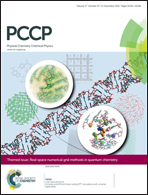Theoretical tools to distinguish O-ylides from O-ylidic complexes in carbene–solvent interactions†
Abstract
In this paper, we report the geometries and properties of 48 molecular species located on the MP2/6-311++G(d,p) PES of the fluorocarbene–(methanol)3 system. The structures were found by a combination of a stochastic search method, using a modified Metropolis acceptance test, and some hand constructed very symmetrical structures. We use several theoretical descriptors to categorize these species, focusing our attention on the interaction between the carbene carbon and the methanol oxygen, Cc⋯O, because this is the key interaction in the formation of O-ylides, ether products, and O-ylidic solvation complexes. These descriptors include natural charges and natural bond orbitals (NBO), Cc⋯O bond orders, Cc⋯O distances, energetic stabilities, and properties at bond critical points. Accordingly, the isomers were divided into four groups: ethers, fluorocarbene–methanol O-ylides, O-ylidic carbene–solvent complexes and hydrogen bonded carbene–solvent complexes. We found that the possibility of forming H-bonds among solvent molecules and between the carbene carbon and the hydrogen of the solvent molecule affects the stability, structure and nature of Cc⋯O interactions in O-ylides and O-ylidic complexes to the point of generating some diffuse borderlines between these two kinds of species. We determined which set of theoretical tools is suitable to better distinguish between them. Additionally, we clarify the nature of the relevant interactions in these species.


 Please wait while we load your content...
Please wait while we load your content...